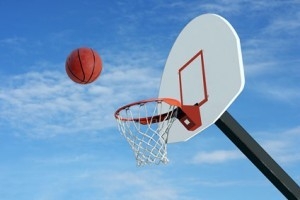BASKETBALL PREPARATION KEYS FOR OPTIMAL BASKETBALL PERFORMANCE, PART 2

Basketball Preparation
Keys for Optimal Basketball Performance, Part 2
Deborah Harris, PT, RD, CLT-LANA
Improving Strength
Stronger athletes are at an advantage from the opening tip. Training in the weight room and always pushing one’s limits builds confidence as much as it does muscle. The more strength they can unleash, the more amazing feats they can accomplish. A stronger basketball is able to battle physically for positioning on the court, rebounds, and can transition from offense to defense or vice versa quicker (i.e. outlet pass up-court).
- Begin each session with a warm-up.
- Provide thorough instruction on the exercises. Competent and close supervision is vital in the beginning stages of the program.
- Avoid single maximal lifts (the load you can lift once, i.e. you can¡¯t perform two repetitions of the load in succession), in particular overhead lifts, until the end of adolescence. During adolescence, training should be sub-maximal.
- Avoid explosive lifts (high-velocity, low-load lifts) in early adolescence and introduce them with caution in late adolescence. The same applies to high-intensity plyometric (jump) training.
- Progress exercises from using the body weight with a load of low volume to traditional weightlifting exercises with a load of high volume and/or high intensity in a systematic and safe way.
- Progressively overload the training (e.g. apply more load, more repetitions, etc.) in small increments. A general rule is to increase the training load by no more than 10% per week (some individuals may require a slower increase).
- Ensure adequate recovery between training sessions. A beginning training frequency of two to three times per week is desirable.
- Include exercises for all muscle groups and provide balance between opposing muscle groups (e.g. quadriceps and hamstrings).
Agility Training
Agility is not necessarily about pure, natural speed – but instead stems from balance and anticipation. Agility is one of basketball”s key ingredients when it comes to performance. There is no “proper” way when training agility; some coaches focus on “suicides”; some focus on footwork exercises using agility ladders; some focus on lateral movements. Whatever the workout, proper body, foot and head positioning are crucial for creating a quick first step on a defender, keeping in front of the opposition”s best penetrator, or assisting in proper help side defense.
Improving Endurance
In any given sport, and basketball included, the better conditioned athletes are the ones who win the day. Endurance training in basketball breaks down into several categories. Speed endurance tests your ability to sustain a certain speed throughout a game or practice. Speed endurance drills often involve sprinting and shuffling for extended periods of time. Strength endurance must be developed in order to stay physical throughout an entire basketball game. Strength endurance is most important for power forwards and centers who need to rebound and box out throughout an entire game. Other endurance training categories include aerobic endurance and anaerobic endurance which is more important for guards who are involved in full-court presses and trapping defenses.
Vertical Jump/”Getting Air”
Whether you are a professional or someone who plays recreational or competitive basketball, vertical exercises are crucial in training explosiveness. According to the Vertical Jump Training website, “Plyometric exercises are designed to increase your reactive strength. Reactive strength is sort of like a spring. The more reactive strength you have, the faster you can react from one motion and do another motion.”
There are hundreds of vertical jumping programs out there – they all fall under these basic categories: plyometric training, strength training, and/or specialized equipment.


